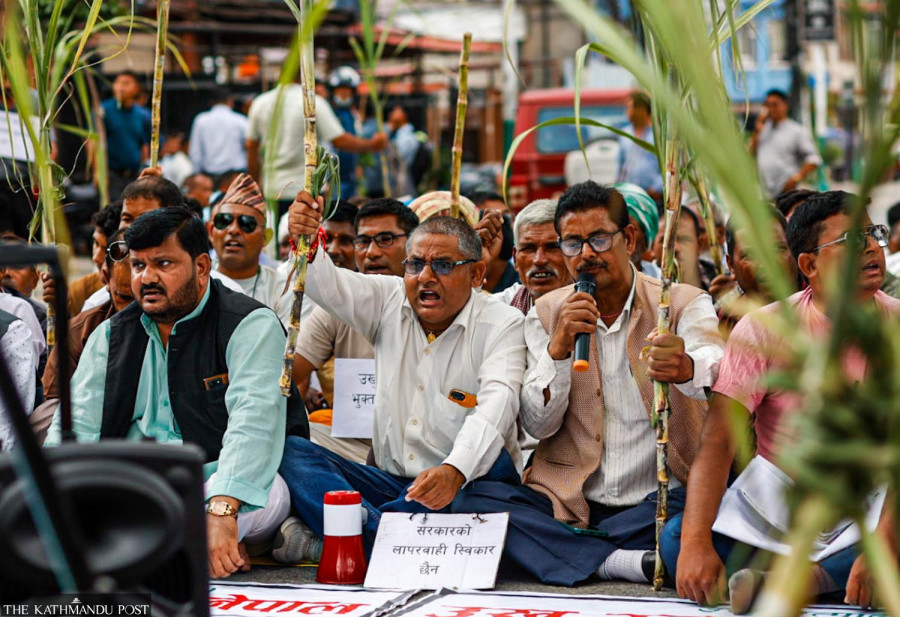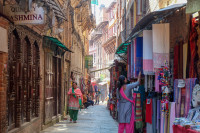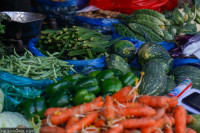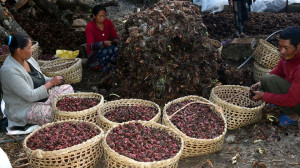Money
Sugarcane farmers protest in Kathmandu as government halves subsidy
Growers from the Tarai say rising production costs and subsidy cuts have pushed them into debt, and warn of roadblocks if demands are ignored.
Krishana Prasain
Seventy-nine-year-old sugarcane farmer Mithai Lal Mallah from Paratappur Rural Municipality, Parasi, has been sitting in protest under the scorching sun at Maitighar, Kathmandu, demanding subsidy amounts farmers received from the government in previous years.
Mallah sold 500 quintals of sugarcane harvested from one bigha land to a sugar mill. This time, he has not received the full subsidy.
“I was supposed to get Rs70 per quintal. But when I heard that the government had cut the subsidy pay, I was frustrated,” Mallah told the Post on Monday. It shows that the government does not care for farmers, he said.
Sugarcane production costs are high and the subsidy helps farmers recover some of it. The government-fixed minimum support price, Mallah said, does not cover even half the production cost.
Mallah, who supports a family of ten, said he was compelled at an old age to travel to Kathmandu to fight for his right. This greedy government holds back a small amount of money promised to farmers, he lamented.
On Saturday, Wajul Ansari, another farmer from Bishrampur Rural Municipality in Bara, also arrived in Kathmandu. He claims the government owes him Rs40,000 in subsidy.
“We will not go home until the government gives us our subsidy,” said the 48-year-old farmer, who supports a family of four.
What disheartens Ansari is that farmers of the Tarai, who already suffered losses in paddy production due to delayed rainfall, are compelled to protest again for the sugarcane subsidy.
He sold 400 quintals of sugarcane to the mill last season. Rising labour costs, untimely fertiliser supply, and subsidy cuts are making it impossible for farmers to survive.
Rishi Devdas Patel from Nawalparasi shared the same frustration.
He expects Rs52,000 in subsidy after selling 500 quintals of cane this year. “If this hassle continues, I will stop planting sugarcane,” Patel said. “We have taken loans from banks for sugarcane farming. Without the subsidy, how will we repay the loans?”
He added that the support price barely covers ploughing, irrigation, electricity, fertiliser, and labour expenses. Patel is considering switching to banana or paddy farming.
Cane farmers have warned of blocking highways and continuing protests in Kathmandu if their demands are not met by August 30.
On Monday, farmers’ representatives met Agriculture Minister Ram Nath Adhikari, who assured them of providing the full subsidy of Rs70 per quintal.
The government decision to cut the subsidy has become the flashpoint of protests.
On July 7, the Cabinet halved the subsidy to Rs35 per quintal, citing growing pressure on the treasury. The decision came amid farmers’ complaints that production costs had surged sharply.
Although the agriculture ministry had requested continuation of the full subsidy, the finance ministry and the Prime Minister’s Office rejected the proposal.
Last November, the government set the minimum support price for sugarcane at Rs585 per quintal, only Rs20 more than in the previous year. Farmers said they had sold their harvests hoping that the promised subsidy would come their way.
“We will not return home unless the government provides Rs70 per quintal as assured,” said Ashok Prasad Yadav, a Sugarcane Farmers Struggle Committee member from Garuda Municipality-2 in Rautahat.
Farmers calculate that the government owes them around Rs1.6 billion in subsidies. They also demand consultation with farmers' representatives when determining support prices, accusing the government of fixing prices unilaterally in favour of middlemen.
On the first day of their protest, farmers said they received no invitation from the government for talks. They added that while sugar mills have cleared this year’s payments, the subsidy remains unpaid.
According to the committee, more than 1,000 sugarcane farmers have arrived in Kathmandu from districts including Kanchanpur, Kailali, Nawalparasi, Parsa, Bara, Rautahat, Sarlahi, Mahottari, Dhanusha, Morang, and Sunsari.
For now, the farmers’ struggle committee has decided to continue peaceful protests at Maitighar until August 30, after which further protest programmes will be announced if necessary.
Officials at the agriculture ministry say they are caught in a bind. “We mobilised the budget provided by the finance ministry. This time, as we did not get sufficient funds, the subsidy amount was reduced,” said Ram Krishna Shrestha, a joint-secretary at the ministry.
He added that informal discussions with protesting farmers were ongoing and a meeting would be called soon.
Since the matter has political connection, officials said, a broader political agreement is needed for a resolution.
This is not the first time sugarcane farmers have staged a protest in the Capital.
On August 3, they submitted a memorandum to Prime Minister KP Sharma Oli through the respective chief district officer demanding the Rs70 subsidy.
On August 4, they burned tyres in front of sugar mills.
On August 13, representatives from each sugar-producing district came to Kathmandu hoping to meet the prime minister, but were denied an audience.
The government introduced the sugarcane subsidy programme in 2018 after repeated complaints that mill owners were not paying farmers adequately.
Farmers say the current policies are contradictory. While subsidies to farmers are slashed, the government has reduced sugar import duties and waived taxes on imports, ostensibly to bring down consumer prices.
This year, customs duty on sugar was cut from 30 percent to 15 percent to provide relief to manufacturers and consumers. Despite these measures, retail sugar prices hover between Rs100 and Rs110 per kilogram.
Farmers argue that such policies clearly favour middlemen and traders at the expense of producers and consumers.




 6.1°C Kathmandu
6.1°C Kathmandu















